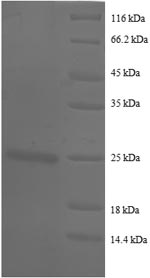The production of the recombinant human basigin (BSG) is through the expression of the gene fragment mapping within amino acids 138-321 of the human BSG protein in E.coli. This partial-length recombinant BSG protein is tagged with a 6xHis motif at the N-terminus, which allows for purification of this fusion protein through metal affinity chromatography. Its purity is greater than 90% determined by SDS-PAGE. It migrated to the molecular weight band of approximately 25 kDa on the gel. The target protein BSG, also called CD147 or EMMPRIN, is important in vision, spermatogenesis, and other physiological phenomena. It also plays a significant role in the pathogenesis of numerous diseases, including cancer. Recent findings point out that BSG exerts a significant role in SARS-CoV-2 invasion as a binding partner for the SARS-CoV-2 spike protein.






